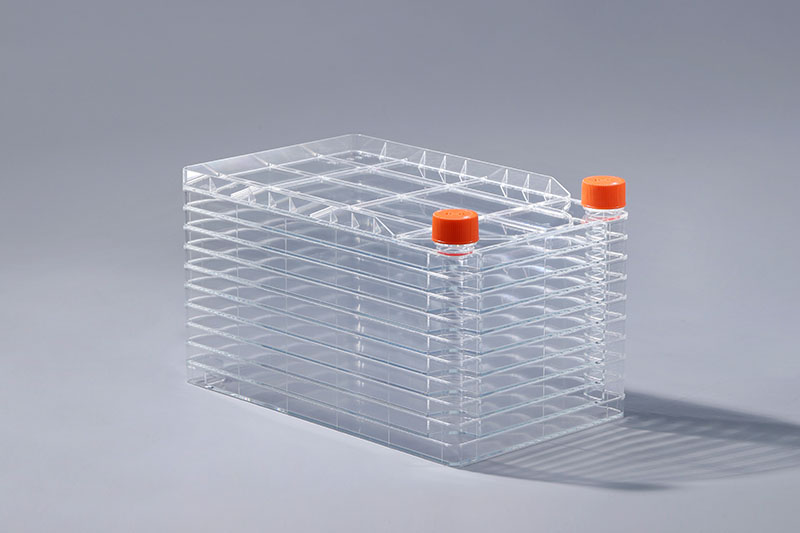হল পলিস্টাইরিন (PS) কাঁচামাল দিয়ে তৈরি একটি সেল কালচার ব্যবহারযোগ্য। এটি একটি মাল্টি-লেয়ার স্ট্রাকচার ডিজাইন গ্রহণ করে। সাধারণ স্পেসিফিকেশন 1 স্তর, 2 স্তর, 5 স্তর, 10 স্তর, এবং 40 স্তর অন্তর্ভুক্ত। প্রয়োজন অনুসারে স্তরের সংখ্যা কাস্টমাইজ করুন। সুতরাং, এই বিশেষ কাঠামোর জন্য কোন উৎপাদন প্রক্রিয়া ব্যবহার করা হয়? সেল ফ্যাক্টরিতে ব্যবহৃত ইনজেকশন ছাঁচনির্মাণ প্রক্রিয়া প্রধানত নিম্নলিখিত ধাপগুলিকে অন্তর্ভুক্ত করে:cell factory
1। প্রাক-ঢালাই প্রক্রিয়া:
প্রি-মোল্ডিং প্রক্রিয়া হল যে প্লাস্টিক উপাদানটিকে উত্তপ্ত, পরিবহন, সংকুচিত, শিয়ার করা, মিশ্রিত এবং ব্যারেলে একজাত করা হয় যাতে উপাদানটিকে একটি কাচের অবস্থা থেকে একটি সান্দ্র তরল অবস্থায় রূপান্তরিত করা হয়। ইনজেকশন ছাঁচনির্মাণের প্রয়োজনীয়তা পূরণ করুন।
2. ইনজেকশন ছাঁচনির্মাণ প্রক্রিয়া:
ইনজেকশন ফিলিং পর্যায়ে, স্ক্রু স্টোরেজ চেম্বারে গলে যাওয়াকে অগ্রভাগ, মোল্ড রানার এবং ইনজেকশন সিলিন্ডারের থ্রাস্টের নিচে গেটের মাধ্যমে গহ্বরে প্রবেশ করায়।
3। সংকোচন এবং সংকোচন প্রক্রিয়া:
সংকোচনের কারণে অংশ দ্বারা খালি হওয়া ভলিউম পূরণ করতে ইনজেকশন ছাঁচনির্মাণ চালিয়ে যান।
4। কুলিং এবং সেটিং প্রক্রিয়া:
হোল্ডিং প্রেসার শেষ হওয়ার পরে, গেট হিমায়িত হয়। নিবন্ধটি শীতল এবং সেট করার সময়কালের মধ্য দিয়ে যায়।
5. ইজেকশন পিকআপ প্রক্রিয়া:
পণ্যটি কিছু সময়ের জন্য ঠান্ডা হওয়ার পর, এটির একটি নির্দিষ্ট দৃঢ়তা এবং শক্তি থাকে। ছাঁচের ইজেক্টর পিন দ্বারা ইনজেকশন ছাঁচ থেকে অংশটি বের করা হয়।
সেল ফ্যাক্টরির উৎপাদন শেষ হওয়ার পর, প্রতিটি স্তরকে একত্রিত করতে হবে, এবং তারপরে এটি শুধুমাত্র বিভিন্ন পরীক্ষার পর কারখানা ছেড়ে যেতে পারে যেমন টাইটনেস। এবং বন্ধ্যাত্ব। কোষগুলিকে আরও ভালভাবে মেনে চলতে পারে তা নিশ্চিত করার জন্য, এই ভোজনযোগ্যটিও হাইড্রোফিলিক ফ্যাক্টর প্রবর্তনের জন্য পৃষ্ঠের টিসি দিয়ে চিকিত্সা করা দরকার।
After the production of the cell factory is completed, each layer needs to be assembled, and then it can only leave the factory after various tests such as tightness and sterility. In order to ensure that cells can adhere better, this consumable also needs to be treated with TC on the surface to introduce hydrophilic factors.
The FAI climbed 5.9 percent year-on-year in the first 11 months of 2018, quickening from the 5.7-percent growth in Jan-Oct, the National Bureau of Statistics (NBS) said Friday in an online statement.
The key indicator of investment, dubbed a major growth driver, hit the bottom in August and has since started to rebound steadily.
In the face of emerging economic challenges home and abroad, China has stepped up efforts to stabilize investment, in particular rolling out measures to motivate private investors and channel funds into infrastructure.
Friday's data showed private investment, accounting for more than 60 percent of the total FAI, expanded by a brisk 8.7 percent.
NBS spokesperson Mao Shengyong said funds into weak economic links registered rapid increases as investment in environmental protection and agriculture jumped 42 percent and 12.5 percent respectively, much faster than the average.
In breakdown, investment in high-tech and equipment manufacturing remained vigorous with 16.1-percent and 11.6-percent increases respectively in the first 11 months. Infrastructure investment gained 3.7 percent, staying flat. Investment in property development rose 9.7 percent, also unchanged.
 English
English



















































